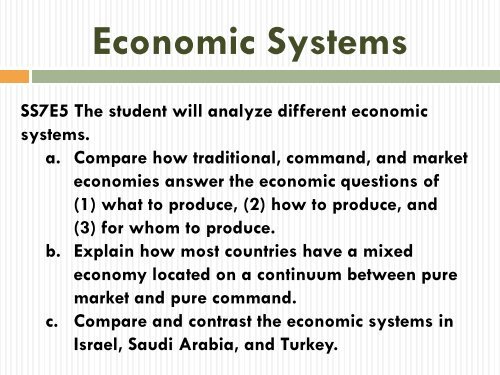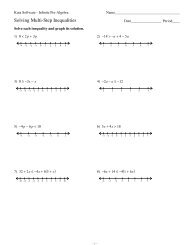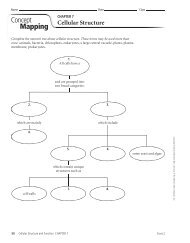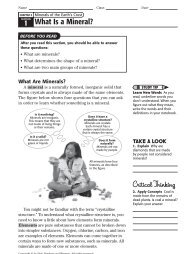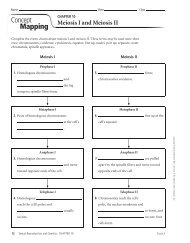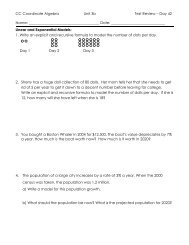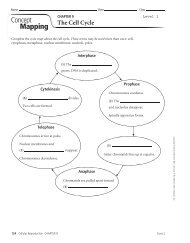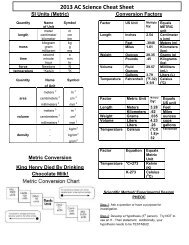PDF â Economics Introduction and Systems - Cobb Learning
PDF â Economics Introduction and Systems - Cobb Learning
PDF â Economics Introduction and Systems - Cobb Learning
Create successful ePaper yourself
Turn your PDF publications into a flip-book with our unique Google optimized e-Paper software.
Economic <strong>Systems</strong>SS7E5 The student will analyze different economicsystems.a. Compare how traditional, comm<strong>and</strong>, <strong>and</strong> marketeconomies answer the economic questions of(1) what to produce, (2) how to produce, <strong>and</strong>(3) for whom to produce.b. Explain how most countries have a mixedeconomy located on a continuum between puremarket <strong>and</strong> pure comm<strong>and</strong>.c. Compare <strong>and</strong> contrast the economic systems inIsrael, Saudi Arabia, <strong>and</strong> Turkey.
What is <strong>Economics</strong>?‣ <strong>Economics</strong> is the production, distribution,<strong>and</strong> consumption of goods <strong>and</strong> services.‣ There are three main economic systems:TraditionalComm<strong>and</strong>Market‣ Most countries around the world have amixed economy (a mixture of the threesystems listed above).
Essential Economic Vocabulary‣ Production – The process of manufacturing or growing something.‣ Distribution – The delivery of products to various places.‣ Consumption – The use of goods <strong>and</strong> services.‣ Goods – Items that are sold.‣ Services – Work that helps others. Ex: Hospital.‣ Gross Domestic Product (GDP) – The total value of goods <strong>and</strong>services produced in a country every year.
Traditional, Comm<strong>and</strong>, Market<strong>and</strong> Mixed Economies‣ The type of economic system utilized by acountry (traditional, comm<strong>and</strong>, market, or mixedeconomies) answer three important economicquestions: What to produce? (What products areproduced in the country?) How to produce? (How are productsproduced in the country?) For whom to produce? (Who are you makingthe products for?)
Comm<strong>and</strong> Economy‣ In a comm<strong>and</strong> economy, thegovernment answers the threeeconomic questions.‣ Characteristics of a comm<strong>and</strong>economy:Little individual freedomNo competition b/ businesses.Businesses are not for profit.Consumers have few choices.Gov’t determines jobs & setsprices of goods/services.Examples: Cuba, North KoreaNorth Korea's leader Kim JongUn greets students at a schoolin Pyongyang.
Economic Case Study #1 - Israel‣ What to produce? A large portion of Israel’s GDP (Gross Domestic Product)comes from high tech manufacturing, financial services(such as banking), <strong>and</strong> agriculture.‣ How to produce? Israel has substantial government ownership of business,but is gradually privatizing companies (allowing privatecitizens to own the company).‣ For whom to produce? Goods <strong>and</strong> services are produced for domestic <strong>and</strong>international markets based on the market price system.
Where is Israel on theEconomic Continuum?‣ Where would Israel fit on the Economic Continuum? Slightly to the market side of center on the continuum. According to the 2013 Index of Economic Freedom,Israel received an overall score of 66.9%.0PureComm<strong>and</strong>50MixedEconomyIsrael66.9%(51 st out of177 countries)100PureMarket
Economic Case Study #2 – Saudi Arabia‣ What to produce? Saudi Arabia is the world’s leading producer of oil. The Saudi governmentcontinues to invest in industrial production (factories). They are a leader inpetrochemicals (chemicals made from oil), mining, <strong>and</strong> refining.‣ How to produce? Over 95% of the oil industry in the country is operated by the government.Most other major industries have significant government involvement. Saudi Arabia relies heavily on specialized labor from other countries.Estimates are that a third of the labor force falls in this category. Since the 1980s, the Saudi government has been trying to increase privateownership of business <strong>and</strong> encourage more joint ventures with privateforeign companies.‣ For whom to produce? One third of Saudi Arabia’s GDP is based on exports to other countries.(This is due to the economy’s reliance on the oil sector.)
Economic Case Study #3 - Turkey‣ What to produce? Turkey has a diversified economy with large service,manufacturing, <strong>and</strong> agricultural sectors.‣ How to produce? Since the late 1980s, Turkey has gradually movedfrom a government directed economy to moreprivate enterprise.‣ For whom to produce? One fifth of Turkey’s production is exported. Theremainder is consumed by domestic consumers <strong>and</strong>the government.
Southwest Asia Economic ContinuumWorldAverage57.6%SaudiArabia60.6%(82 nd out of177 countries)Israel66.9%(51 st out of177 countries)0PureComm<strong>and</strong>50MixedEconomyTurkey62.9%(69 th out of177 countries)100PureMarket


